Lying approximately 100 miles south of the Greek mainland in the southern Aegean Sea at the crossroads of the continents of Europe, Asia and Africa, Crete is the largest of the Greek islands and is home to 115 PM (Pterix Mahis – Combat Wing) of the Hellenic Air Force, operating the potent Lockheed Martin F-16C/D Block 52+. 115 PM comprises two Mira (squadrons), 340 Mira “Aleppou” (Fox) and 343 Mira “Asteri” (Star), along with the 115 PM SMET (Operational Conversion Unit), “Assos” (Ace). 115 PM operates from Chania Air Base, a sprawling airfield shared with a bustling United States Navy facility and developing international airport both situated across the runway from two of the Hellenic Air Force’s premier combat squadrons. Tom Gibbons reports for GAR.

Set with the stunning backdrop of the White Mountains Chania Air Base provides some beautiful opportunities for the photographer © Tom Gibbons – Global Aviation Resource

Toting AGM-88 HARM, AIM-120C-7 AMRAAM and AIM-9Li missiles, this 343 Mira F-16C Block 52+ pauses briefly for the camera © Tom Gibbons – Global Aviation Resource
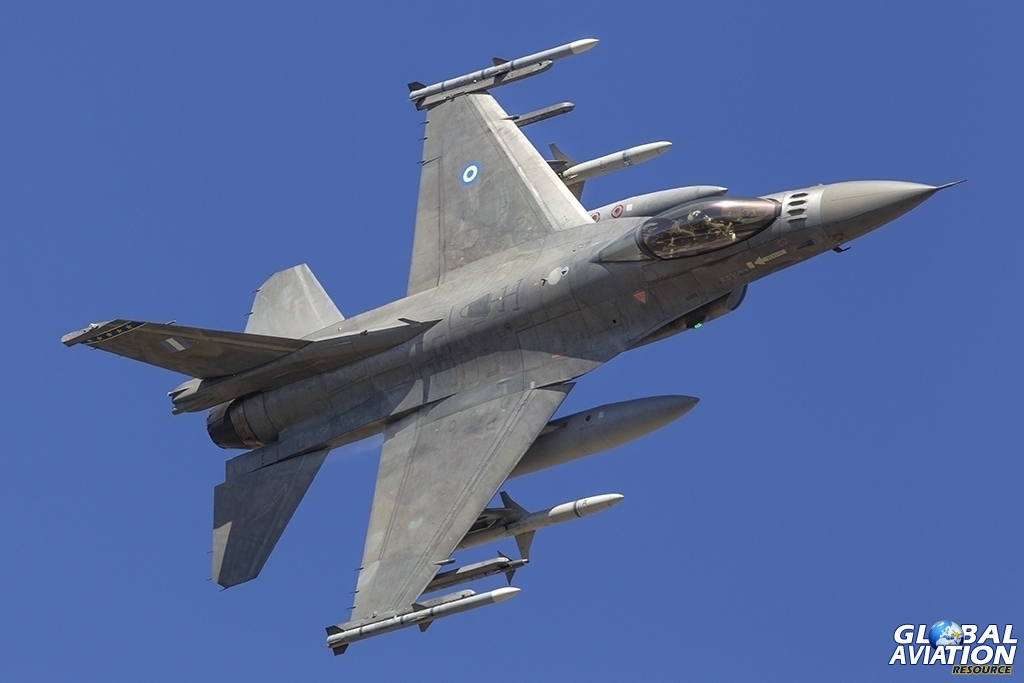
A SEAD equipped 343 Mira F-16C Block 52+ over the Aegean Sea © Tom Gibbons – Global Aviation Resource
340 Mira was established on 18 April 1953 within 112 PM at Elefsis, near Athens, initially equipped with the Republic F-84G Thunderjet, and in September of the same year the squadron transferred to 111 PM at Nea Anghialos. Following five years’ service the F-84G was replaced by the F-84F Thunderstreak, a type that would serve the Hellenic Air Force well until the introduction of the A-7 Corsair II in 1975. In February 1960 the unit relocated to the then 115 Combat Group in Souda, from where it operates to this day.
The arrival of the Ling-Temco Vought A-7H & TA-7H Corsair II in August 1975 heralded a long association with the robust ‘SLUF’, an aircraft which grew to be loved by those that flew and maintained it. The squadron made its latest and arguably its most technological advance in March 2003, nearly 50 years after its formation at Elefsis, when it exchanged the trusty A-7 for the Lockheed Martin F-16C/D Block 52+ Fighting Falcon, supplied to Greece under the Peace Xenia III programme. With this variant of the F-16, the Hellenic Air Force entered the world of long-range missions and precision day and night strike.

Conformal Fuel Tanks (CFTs) free up valuable wing stations for munitions whilst the bulged dorsal spine houses avionic and mission systems along with additional chaff & flare dispensers © Tom Gibbons – Global Aviation Resource

A trio of 340 Mira F-16s wait patiently at the EOR whilst ground crew complete the last chance checks © Tom Gibbons – Global Aviation Resource

Fitted out with CFTs and a single belly mounted fuel tank, this 340 Mira F-16C Block 52+ taxis for take off © Tom Gibbons – Global Aviation Resource
Sister squadron 343 Mira was formed in September 1955, operating the North American F-86E Sabre from Elefsina Air Base within 111 PM, where the squadron was given the role of daytime interception. Six years later in 1961 the F-86D replaced the ‘E’ version, with the resultant expansion of the squadron’s role to encompass night interception. The ‘Sabre Dog’ was employed by 343 Mira for a relatively short five year period and in 1966 the squadron transitioned to the Northrop F-5A/B Freedom Fighter, with a primary role of day interception and a secondary role of air-to-ground strike. With a move to 113 PM at Macedonia Airport undertaken in 1974, the F-5 continued to serve 343 Mira well for a period of 35 years until March 2001 when operations were temporarily suspended.
The squadron stood up again in July 2003 as part of 115 PM at Souda Bay, Crete, flying the F-16C/D Block 52+ in a primary interception role with a secondary Suppression of Enemy Air Defences (SEAD) role. The unit is extremely proud of its heritage and status and considers itself honoured to be entrusted with around-the-clock protection of the southern sector of Hellenic airspace, where it maintains a continuous presence in the wider region of the eastern Mediterranean.
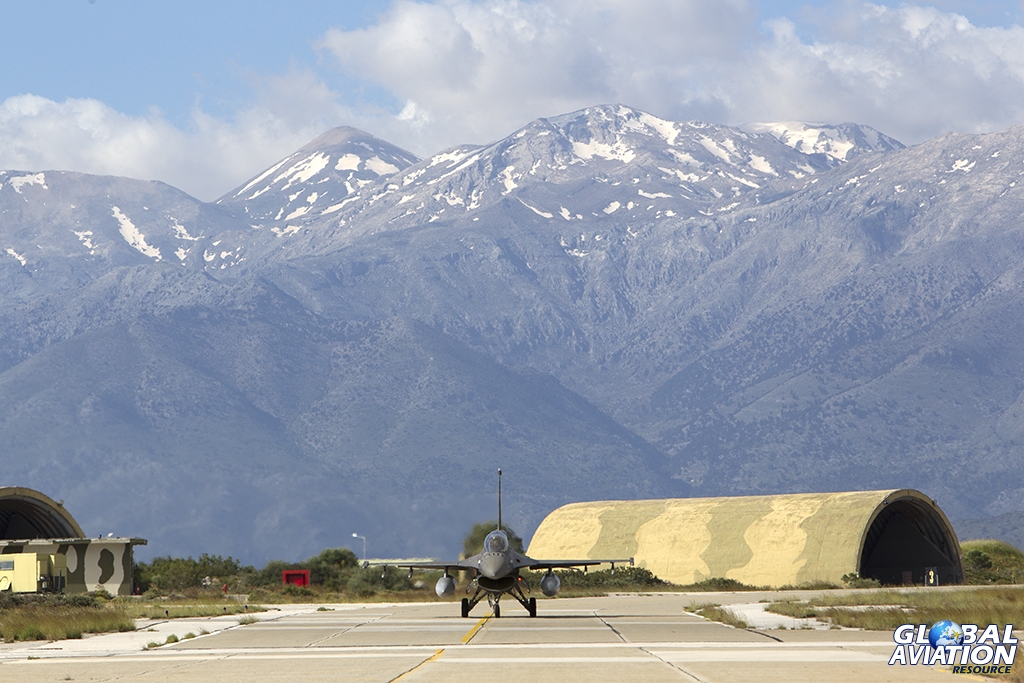
The breathtaking White Mountains provide an impressive backdrop as a 343 Mira F-16D Block 52+ departs the shelter area at the start of a morning sortie © Tom Gibbons – Global Aviation Resource
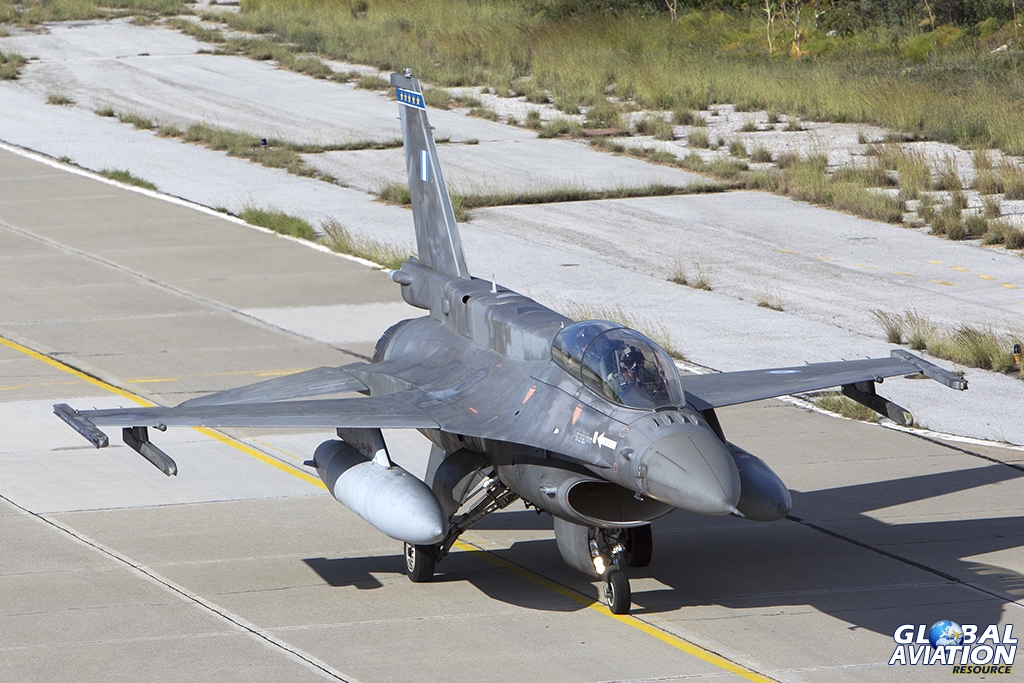
The current paint finish gives the 115 CW aircraft a distinctly weathered appearance. A 343 Mira F-16D Block 52+ taxis for take-off © Tom Gibbons – Global Aviation Resource

Break right!! A SEAD equipped 343 Mira F-16C Block 52+ pulls hard over the Aegean Sea © Tom Gibbons – Global Aviation Resource
GAR spoke to both current squadron commanders regarding the roles of their respective units, their day-to-day operations and their experiences flying the F-16 Block 52+. Major Athanasios Antonakakis, an ex-F-5 Freedom Fighter pilot, is the current Commanding Officer of 340 Mira, with over 1,000 hours on the F-16C/D Block 52+, whilst Lt. Col Michail Tsikalakis is the current Commanding Officer of 343 Mira, with over 1,000 hours on the F-16C/D Block 52+, and also one of many ex A-7 Corsair II pilots now flying the Block 52+ at Souda:
The training course for a new F-16 pilot consists of familiarisation, Air to Air and Air to Ground sorties with advanced mission scenarios and lasts approximately 8 months and 60 sorties. Once the new pilot joins the squadron from the operational conversion unit (115 PM/SMET) it then takes a further 8 months for the pilot to become Combat Ready. The OCU also conducts refresher training for pilots returning to flying duties following a ground posting with the duration of this refresher training being dependant on the flying experience of the individual returning to flying duties.
Both the 115 PM squadrons, 340 and 343, have specific, specialised roles that are not interchangeable. The current role of 340 Mira is precision day and night with tasking for the squadron being dependent on instructions received from the tactical headquarters with an approximate split of flight scheduling of 60% day operations and 40% night operations. 343 Mira has a primary role of interception and force protection with a secondary SEAD role. Both 340 and 343 Mira maintain currency in Air to Air Refuelling operations utilising tanker support from both Israel and the USA in Greek airspace and both have the additional commitment to undertake readiness duties to defend national airspace

In addition to their primary roles, both 340 & 343 Mira maintain the additional commitment to undertake readiness duties to defend national airspace. A 340 Mira F-16C Block 52+ armed with a pair of wingtip mounted AIM-120 C7 AMRAAM pulls hard during a low-level sortie © Tom Gibbons – Global Aviation Resource

Precision day and night strike is the domain of 340 Mira. This F-16D Block 52+ features a chin mounted LANTIRN pod and Conformal Fuel Tanks (CFT) and is armed with a pair each of Paveway III Laser Guided Bombs, AIM-120 C7 AMRAAM and AIM-9Li missiles © Tom Gibbons – Global Aviation Resource

The F-16 cockpit is a compact working environment for the pilots of 340 & 343 Mira © Tom Gibbons – Global Aviation Resource
The F-16C/D Block 52+ is a hugely capable weapon system and utilises a wide spread of precision strike weapons whilst also boasting the capability to be fitted with the distinctive Conformal Fuel Tanks (CFTs):
Major Antonakakis: “We currently use a wide range of weapons on our aircraft; AIM-120C7 AMRAAM and AIM-2000 (IRIS-T) air-to-air missiles with Paveway I & III Laser Guided Bombs and AGM-65 Maverick missiles utilised for precision strike. The use of the Conformal Fuel Tanks offers greater flexibility [for us] without having an effect on aircraft performance. Furthermore, in the air-to-air scenarios when used in conjunction with the hi-tech {sic} fire control system, sophisticated radar and helmet mounted sight (Joint Helmet Mounted Cueing System) the CFTs give us the advantage in any conditions of air battle”
Lt.Col Tsikalakis – “343 uses AIM-9Li, AIM-2000 (IRIS-T) and the AIM-120C& AMRAAM in the air-to-air arena whilst the AGM-88 HARM is the weapon of choice in the anti-RADAR SEAD role. The CFTs contribute to an increase in the capabilities of the aircraft whilst at the same time allowing the aircraft to retain its phenomenal manoeuvrability”
Interoperability is an increasingly important aspect of modern military operations and the squadrons of 115 PM are no different in this respect. Despite having specific roles and training schedules, the two squadrons dedicate time to advanced training aspects including the conduct of combined operations (COMAO) on a weekly basis and participation in a number of international large-scale exercises as and when tasked. 340 Mira had taken part in Exercise Blue Flag at Ovda Air Base, Israel, during early 2014 alongside units from the Israeli Air & Space Force, Italian Air Force and United States Air Force and had also hosted a successful deployment at Souda of F-15E Strike Eagles from the USAFE’s 494th Fighter Squadron from RAF Lakenheath, England. 343 Mira participated in Red Flag in 2008 and had also played a part in the SEAD-specific ELITE series of exercises, NATO Air Meet (NAM) and the Tactical Leadership Programme (TLP) courses now held at Albacete, Spain. At the time of GAR’s visit the squadron was preparing for a deployment to Schleswig, Germany, for the JAWTEX 2014 exercise and the wing has, more recently, hosted deployments of USAFE F-16s from the 52nd Fighter Wing at Spangdahlem, Germany, who deployed as the 480th Expeditionary Fighter Squadron.

115 PM maintains a high operations tempo; F-16s from 343 Mira prepare to launch on an afternoon sortie © Tom Gibbons – Global Aviation Resource

Following a morning sortie the informal debriefs commence as soon as the crews are back on the ground © Tom Gibbons – Global Aviation Resource
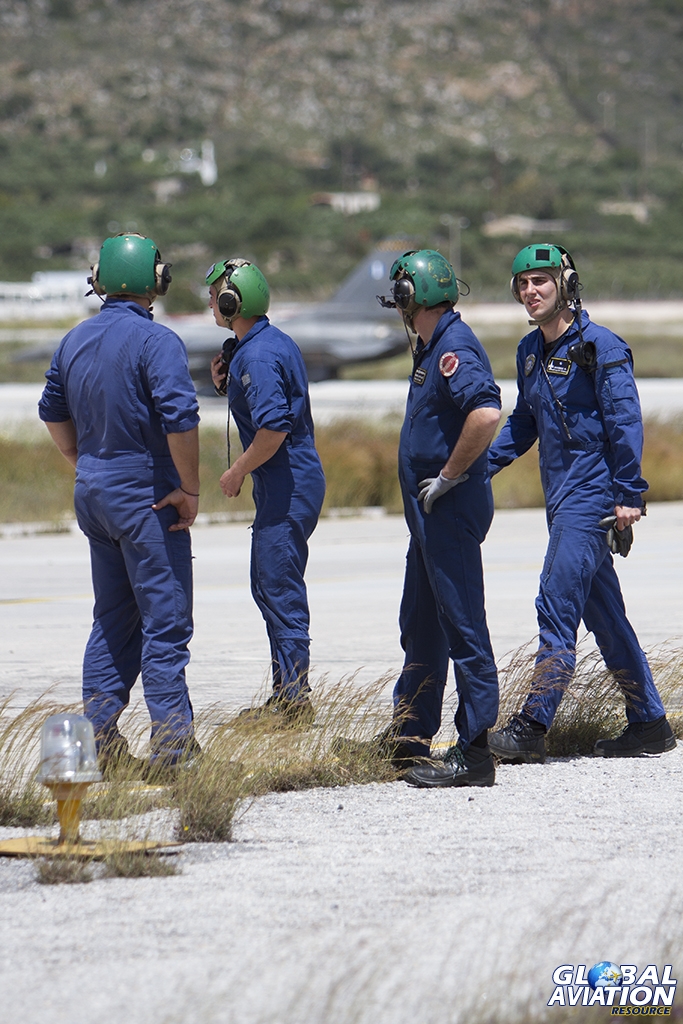
No flying unit achieves much without a dedicated team of engineering and support staff © Tom Gibbons – Global Aviation Resource
No flying squadron achieves much without a dedicated team of engineering and support staff behind them and the squadrons of 115 PM are no exception. All F-16 Block 52+ groundcrew training is carried out at Souda under the auspices of 115 PM/SMET, with it typically taking between six to eight months for groundcrew to qualify on the type. Once assigned to a particular squadron the engineering staff are responsible for all first and second levels of maintenance on the units’ F-16s; during GAR’s visit a number of aircraft were noted receiving different levels of attention in the maintenance hangars, purpose-built for the F-16s at Souda, with activity ranging from relatively simple scheduled activities through to complex structural repairs, lengthy depth maintenance and major component replacement. Additionally, throughout GAR’s visit to 115 PM, the support staff of both squadrons were highly visible supporting a busy flying schedule throughout the day.
A typical day witnessed by GAR saw four-ship sorties launched in both morning and afternoon waves with a smattering of single aircraft sorties taking place in between, some flown by the squadrons themselves and some carrying out training sorties crewed by students and instructors from the SMET (OCU). The morning wave was invariably turned around by the ground crew working efficiently to ensure that the maximum use was gained from each serviceable aircraft available to the aircrew. Aircraft in a wide variety of configurations were noted, ranging from the classic two underwing fuel tanks through to clean-winged aircraft fitted with the distinctive CFTs and a single AIM-9 or AIM-2000 missile. The twin-seat F-16D Block 52+ aircraft are easily discernible by the ‘hump’ dorsal spine which accommodates the avionics equipment from the single seat F-16C, in addition to some special mission equipment and additional chaff/flare dispensers. Increasing the flexibility of the twin-seat F-16D is the ability for the rear cockpit to be configured for either a Weapon System Operator (WSO) or an Instructor Pilot (IP) and can be converted with a single switch in the cockpit.
Night operations are routinely carried out and GAR witnessed elements of a mission brief and subsequent launch of the sortie from the 340 Mira Hardened Aircraft Shelter (HAS) complex by a mixed four-ship of F-16C and D aircraft. From strapping in through to engine start and subsequent taxi to the runway and departure to the west, it was evident that the operation is both well-practiced and professionally executed by both air and ground crews. The sight and sound of the four F-16s, afterburners ablaze, departing into the inky darkness was hugely impressive and left a lasting impression of a wing that was ready for action 24 hours a day, seven days a week.

Most maintenance tasks are performed ‘in-house’ as illustrated by this 340 Mira F-16C Block 52+ © Tom Gibbons – Global Aviation Resource

Night sorties are as important as those conducted during daytime, with the night strike role accounting for around 40% of the tasking for 340 Mira © Tom Gibbons – Global Aviation Resource

Once dusk had passed the four-ship from 340 Mira launched in quick succession for a complex night sortie over the Aegean © Tom Gibbons – Global Aviation Resource
Team Zeus
Greece is one of many F-16 operators to showcase the capabilities of the F-16 alongside the skill and professionalism of its air and ground crews. Work to establish an F-16 demonstration team started in 2009 with a small team from 115 PM undergoing training at Hill Air Force Base, Utah, USA, with the USAF’s highly experienced “Viper West F-16 Demo Team”. The initial pilots selected for Team Zeus were Captain Emmanuel Karahalios from 340 Mira and Captain Dimitrios Kontoulis from 343 Mira along with a small number of ground crew support members. The whole training programme was completed on 1 February 2010 at Souda Air Base, with the first official airshow taking place at 114 PM, Tanagra Air Base.

Zeus Team Leader Captain Giorgos Androulakis gets smartly airborne for a demo rehearsal to the north of the island © Tom Gibbons – Global Aviation Resource

New to the team for the 2014 season was Captain Sotirios Stralis from 340 Mira pictured here during one of his work-up sorties to the north of Souda © Tom Gibbons – Global Aviation Resource
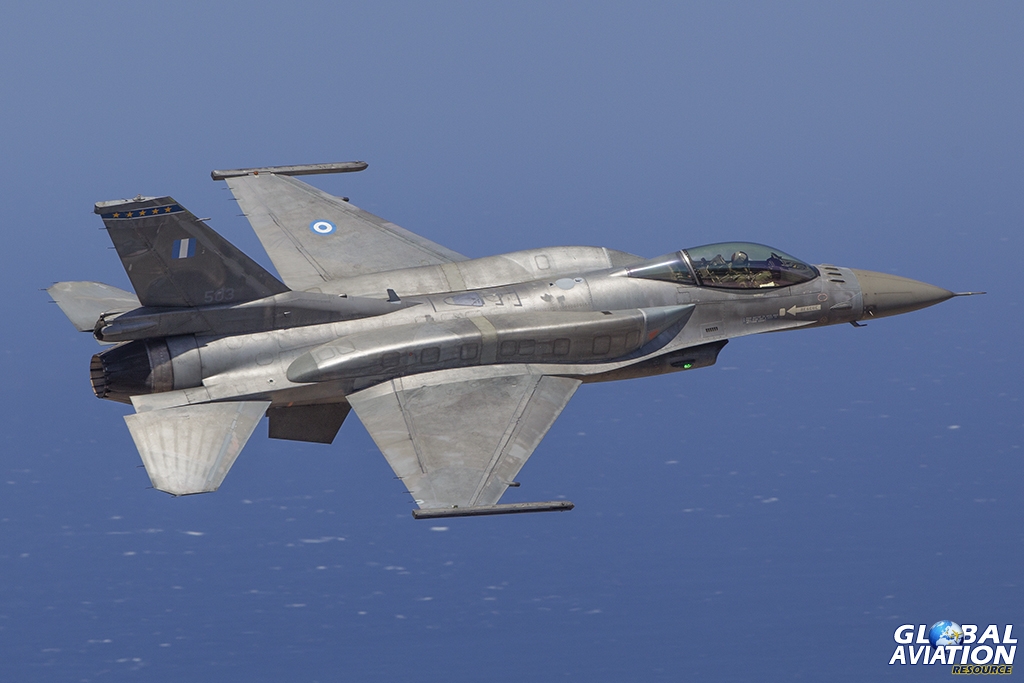
Team Zeus are unique in displaying the F-16 whilst fitted with the Conformal Fuel Tanks (CFTs) © Tom Gibbons – Global Aviation Resource
The current team is led by Captain Giorgios Androulakis of 343 Mira with Captain Sotirios Stralis of 340 Mira working up for his first display season with Team Zeus. GAR asked Captain Androulakis for an overview of the team:
The team display pilots carry out the role for two years, sometimes three in certain circumstances. The work-up period for each pilot varies; during the winter months the pilots are flying to maintain currency and fly around two to four [display] sorties per month depending on their experience. During the season they fly about six to eight [display] sorties per month in order to be fit for the forthcoming shows. The team is supported by dedicated ground support staff who also perform a unique worldwide ground demo.
Given the team’s geographical location, the team predominantly appears at airshows in Greece with two to three international and ten national events appearing on the team calendar last year. Team Zeus is notable for displaying the F-16 with the Conformal Fuel Tanks (CFTs) fitted for the demonstration:
We prefer to demonstrate with CFTs; we are the only team around Europe to demonstrate with them and that makes our show different among the other Viper demos. Of course CFTs gives us the opportunity to demonstrate far away from our motherbase {sic} without having to land somewhere else for refuel. Our first display for 2014 was at Rhodes Island which is 210 nm from Souda Bay!
With thanks to:
Hellenic Air Force Chief’s Staff Office/Press & Information Directorate, Commanding Officer 340 Mira, Major Athanasios Antonakakis, Commanding Officer 343 Mira, Lt. Col Michail Tsikalakis, Team Zeus Leader and Demo Pilot Captain Giorgios Androulakis, 343 Mira, Mrs Caroline Makropoulos, British Embassy Athens.
Invalid Displayed Gallery


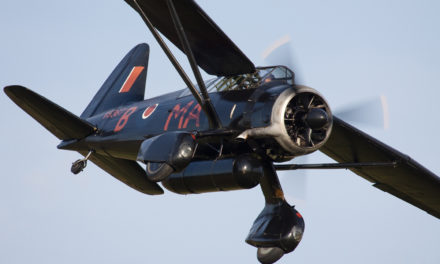

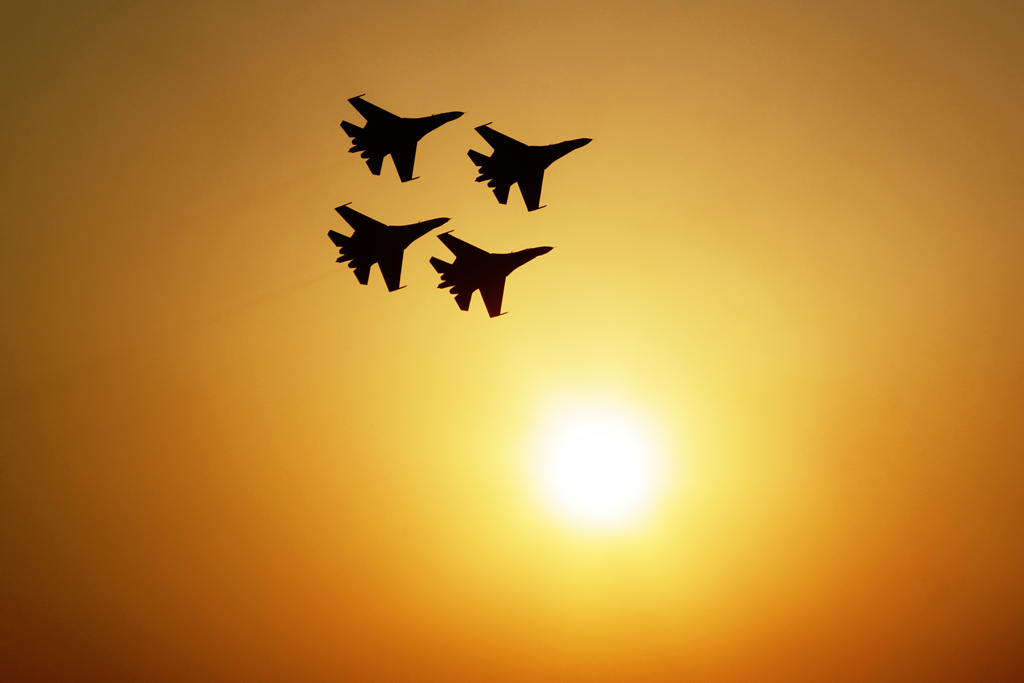
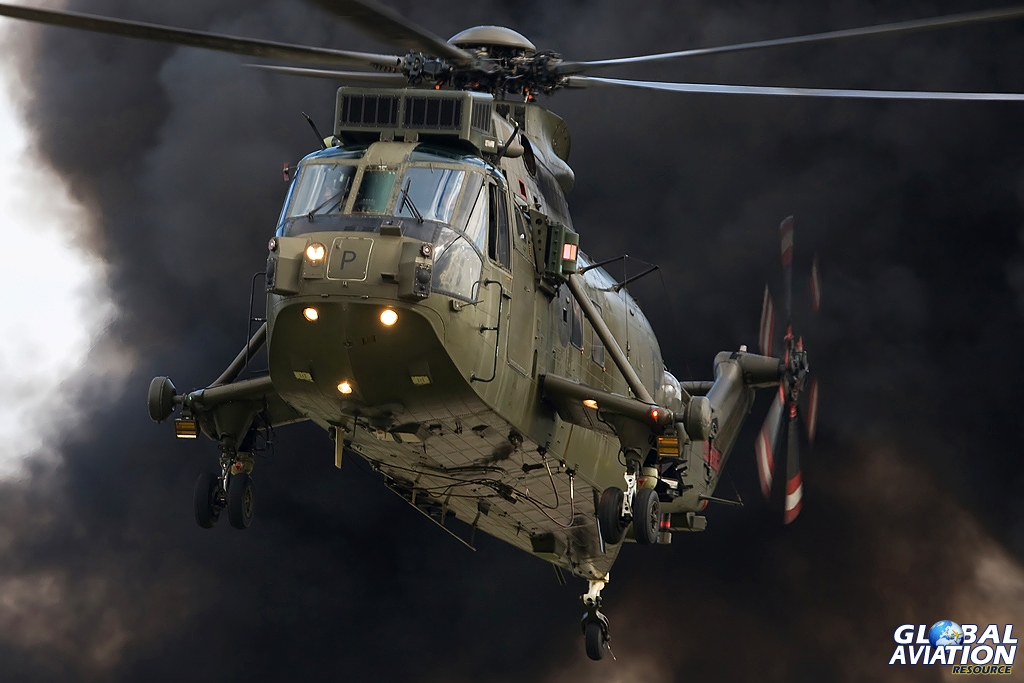
Superb photography and words. Very envious, having been in the international awaiting flights and seeing these beauties fly past.